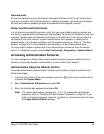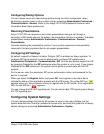
36 Avaya 1010/1020 User Guide
Specifying a Locally Configured IP Address
Dynamic Host Configuration Protocol (DHCP) is used to dynamically allocate and assign IP
addresses. DHCP allows you to move network devices from one subnet to another without
administrative attention. You can choose to enable DHCP if a DHCP server is present. If you
disable DHCP, you must enter an IP address (the locally configured IP address if not
assigned by a DHCP server), subnet mask (used to partition the IP address into a network
and host identifier), and gateway (IP address of the default gateway the system uses).
Configuring Avaya Systems Using DHCP
If an Avaya video communications system obtains its IP address using DHCP (the default), it
can accept an option from the DHCP server that specifies a location and file from which the
system can obtain configuration information. The file can be located on a web server, trivial
file transfer protocol (TFTP) server, or file transfer protocol (FTP) server. Each time the
system boots, it attempts to fetch the configuration file specified by the option. If the
configuration file has changed since the last time it was applied, the system applies the
configuration file before the boot process continues. The following prerequisites must be met
to enable this feature:
•The DHCP preference in Administrator Preferences : Network : General on the
Avaya system must be set to Enabled.
• An Avaya system accepts site-specific option 157 for this feature. You must configure
this option on the DHCP server.
Note: If you configure a system using DHCP option 157 and specify a TFTP server as
the source from which to obtain the configuration file, the system accepts the download
through port 5351. Ensure that firewalls between the system and the TFTP server are
configured to allow the download through this port.


















